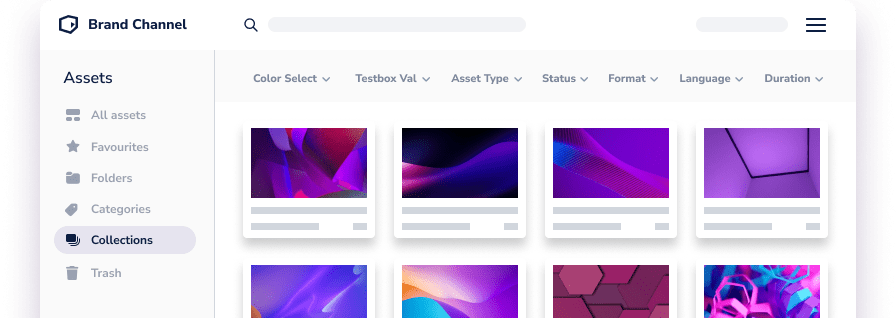PIM vs PXM – Understanding the Key Differences
Digital Asset Management
Updated on April 10, 2025
Product information management (PIM) and product experience management (PXM) are crucial functions within e-commerce today. But what’s the difference between PIM vs PXM?
Though the systems are often intertwined, PIM and PXM are two distinct concepts.
This blog post will delve into the key distinctions between these two essential functions, helping you determine the best strategies for your organisation’s needs.
Introduction to PIM and PXM
Think of PIM and its associated software as an online shop’s backstage crew. A product information management system (PIM system) is a centralised repository for all key product information.
It’s very relevant for online retailers who have tens of thousands of products, each with unique descriptions, digital assets, and specifications.
On the other hand, PXM is like a brand’s front of house team, helping customers understand and interact with the products they make.
PXM solutions typically offer ways to help brands apply this information in a customer-facing context, enhancing how customers discover, interact, and relate to products at retail partners.
The rest of this article takes a closer look into the two processes and how they facilitate enhanced content on the digital shelf.
What is Product Information Management (PIM)?
Product information management is the process or function of storing, organising, managing, and sharing product information like product descriptions, details, and technical specifications. As such, PIM systems are crucial for achieving consistent product presentations across channels.
A PIM solution is nothing without its data, however. Quality product data and properly maintained PIM software enable your teams to create engaging, personalised online shopping experiences for your target audience directly on the product page.
Retailers often use PIM solutions to acquire product data from brands, create product catalogues, and distribute this information across online sales channels.
What is Product Experience Management (PXM)?
Product experience management, on the other hand, is how brands create engaging customer interactions with the products they manufacture.
As a function, PXM ensures a positive experience with a brand’s products, from the moment a potential customer learns about it to the moment they open the box, use it, and beyond.
Product experience is usually included as part of the customer experience, which as a concept is more broad and includes all customer-centric interactions with a brand.
Incorporating PXM into your e-commerce strategy gives you a competitive edge, ensuring customers choose you over others.
Core Objectives of PIM vs PXM
So, which systems do you need to achieve your online sales goals? Let’s take a deeper dive into the differences between PIM vs PXM.
The Goals of Product Information Management
Consider a PIM system as the backbone of your product detail pages. PIM helps with the following:
- Gathering: Collecting your product data in one place.
- Organising: Structuring your data in a way that makes sense for your business.
- Preparing: Getting your product data ready for distribution in the most efficient way possible.
PIM’s primary goal is to boost efficiency by:
- Simplifying Data Management: It makes handling your product information easier.
- Ensuring Consistency: Keeping your product information uniform across your various platforms.
In essence, PIM is an internal practice that focuses on product information and content. It’s a fundamental process for:
- Data Accuracy: Ensuring your product information is correct and up-to-date.
- Compliance: Make sure your product information meets all relevant regulations and standards.
- Efficiency: Streamlining your processes to help your business run smoothly.
As you can see, a PIM system is absolutely crucial for online stores. Without effective PIM strategies, you run the risk of upsetting your suppliers and your customers.
So, which systems do you need to achieve your online sales goals? Let’s take a deeper dive into the differences between PIM vs PXM.
The Goals of Product Experience Management
Product experience management, on the other hand, is how brands manage the way customers perceive products from the moment of discovery. So, helping retailers acquire high-quality product information is an important component of this.
- Enhancing Customer Experience: PXM upgrades the overall customer experience. It’s about managing how customers interact with and perceive products across various channels.
- Customer-Focused: PXM is outward-facing, focusing on the customer’s journey and interaction with the product. It relies on customer data to creating compelling product experiences that truly resonate with your target audience.
- Leveraging Data: PXM helps PIMs structure and leverage data to drive marketing and sales initiatives. PXM helps retailers provide a better shopping experience and a faster time to market, which helps brands ensure engaging customer experiences with their products.
An effective product experience management strategy transforms how you do digital commerce, which is why brands often invest lots of money into a PXM solution.
Key Features of PIM Software
Understanding the distinction between PIM vs PXM is crucial due to their integral roles in enhancing business operations and customer engagement.
Product Information Management Capabilities
- Central Repository of Product Information: PIM solutions provide a single, unified platform where you can store and manage all your product data, product descriptions, and other specs.
- Data Enrichment: PIMs allow you to enhance your product data with additional information, images, and other digital assets to create comprehensive product profiles.
- Data Quality Control: PIM software enables precision and uniformity of your product information on all channels.
Integrations with Other Tools
- E-commerce Platform Integration: PIM tools can seamlessly integrate with common e-commerce platforms used by online stores, ensuring consistent product information across all channels.
- ERP Integration: They can also integrate with your Enterprise Resource Planning (ERP) systems, allowing a more efficient way of managing product data exchange between systems.
- Marketing Tool Integration: PIMs can connect with your marketing tools, enabling you to leverage your product data for marketing campaigns.
- Digital Asset Management Integrations: By integrating PIM and DAM solutions, you can create a seamless platform for the management of all product content.
A robust PIM system is a game-changer for your e-commerce strategy. It not only simplifies product data management but also ensures a consistent and engaging product experience for your customers.
Key Features of PXM Systems
Product Experience Management (PXM) systems are designed to enhance the customer experience. Here are some features:
Focus on Customer Satisfaction Through Interaction
- Personalised Experiences: PXM systems focus on creating personalised experiences for each customer, taking into account their preferences and behaviour.
- Customer Journey Mapping allows you to map out the customer’s journey and understand how they interact with your product at each stage.
- Feedback Mechanisms: PXM systems provide mechanisms for customers to provide feedback, helping you continually improve the product experience.
Tools for Enhancing User Engagement
- Interactive Content: PXM systems enable the creation of interactive content, such as videos and 3D models, to engage customers.
- AI Recommendations: They utilise AI to provide personalised product recommendations, enhancing the shopping experience.
- Omnichannel Consistency: PXM systems ensure a consistent product experience across all online or offline channels.
An effective PXM strategy can significantly impact your e-commerce results. It helps brands control how customers perceive their products before, during, and after purchase.
The Impact on Operational Efficiency
PIM and PXM systems both play a crucial role in enhancing efficiency of operations.
How PIM Affects Internal Processes
- Streamlined Data Management: PIM systems centralise all product data, making it easier for different teams to access and manage this information. This reduces the time spent searching for data and eliminates data silos.
- Improved Data Quality: PIM platforms ensure consistency and accuracy across all platforms by providing a single source of truth for product data. It reduces errors and improves the reliability of your product information.
- Efficient Product Launches: Launching new products becomes a more efficient process with all product data in one place. Teams can collaborate effectively, reducing the time to market.
How PXM Shapes Customer Perceptions and Sales
- Enhanced Customer Experience: PXM systems focus on delivering a personalised and engaging product experience. This not only improves customer satisfaction but also boosts brand perception.
- Increased Sales: By providing a superior product experience, PXM systems can influence purchase decisions and increase sales. They ensure customers have all the information they need to purchase, reducing cart abandonment rates.
- Improved Customer Loyalty: A positive product experience can increase customer loyalty. Customers are more likely to return to your store if they had a good experience the first time around.
Implementing PIM and PXM in E-Commerce
A top-notch PIM solution helps retailers deliver the best, branded product experiences possible.
Rather than separate entities, envision PIM as a way for retailers to acquire, store, organise, and distribute relevant product data (created by brands) for the items they sell.
If online shops and brands can emphasise each other’s PIM and PXM working harmoniously, you can turn regular online shoppers into dedicated brand and product advocates.
Integrating DAM + PIM

For retailers with millions of product assets and tens of thousands of products, it can be hard to keep all that content straight. That’s why many choose to integrate their PIM and DAM systems to create a seamless product content management platform.
Integrating a DAM into a PIM allows online shops to map assets to products, collect all product information in a single place, and ultimately streamline content management processes.
Integrating DAM + PXM
Digital Asset Management (DAM) can be vital component of your PXM stack. DAM is the process of storing, organising, managing, sharing, and publishing digital assets, such as images and videos, to enhance the product experience.
Integrating DAM into your PXM stack enriches your product data and helps you create visually appealing, engaging, personalised shopping experiences for your customers.
DemoUp Cliplister – The Missing Piece of Your Content Management Puzzle

DemoUp Cliplister could indeed be the missing piece of your product content management puzzle.
From content creation and digital asset management, to dynamic media delivery and product content syndication, DemoUp Cliplister has a range of products and services to help with your visual content needs.
- Product Content Solutions: It offers comprehensive product content solutions, helping you to manage your digital assets and automate product content distribution to over 450 retailers.
- Enhanced Customer Experience: We produce product content like 3D/AR models and review videos that customers can access across multiple channels.
- Digital Asset Management: It provides a leading digital asset management software for eCommerce enterprises.
- Increased Interactions: By adding content, you can increase the number of user interactions on your eCommerce site, or shopper interactions with your products which is shown to increase conversions.
Frequently Asked Questions
Still aren’t sure what the differences between PIM vs PXM are? Read through our answers to the most common questions we receive about the topic below.
To see our full product portfolio, visit the homepage.
For more e-commerce tips, tricks, and strategies, visit the blog.
PIM manages product information at the backend, while PXM enhances the customer experience by presenting and using technical data and utilising the data across channels.
PIM systems streamline data management, improve product data accuracy, enhance marketing efficiency, and boost sales by ensuring consistent information across multiple sales channels.
PXM strategies enhance customer experiences, improve product discoverability, optimise conversion rates, and increase engagement by delivering tailored content across all touchpoints.
PIM improves efficiency by simplifying data management and ensuring consistent product information across different platforms. PXM, on the other hand, enhances the customer experience and drives engagement and loyalty.
DemoUp Cliplister offers comprehensive product content solutions, helping both brands and shops manage the full content lifecycle. From content creation services to digital asset management and content syndication software, DemoUp Cliplister has every visual product content need covered.
Better Content. More Sales.

Fill out the form to discover our end-to-end eCommerce content solutions for brands & shops




